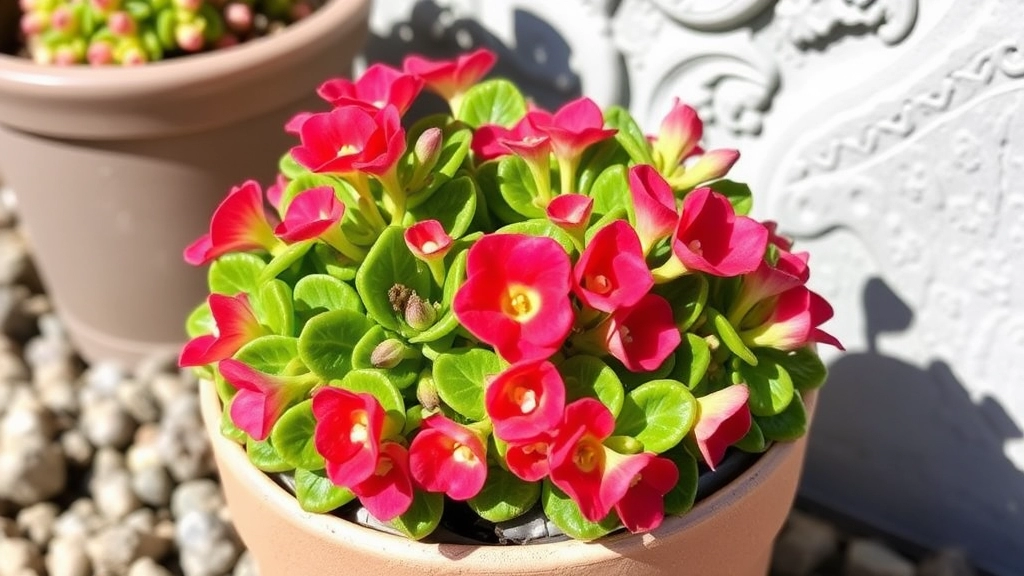Kalanchoe Mother of Thousands: A Unique Plant
If you’re fascinated by unique and resilient plants, the Kalanchoe Mother of Thousands is a must-have for your collection. This intriguing succulent, known for its prolific propagation and distinctive appearance, is both captivating and easy to care for. Whether you’re a seasoned gardener or a curious beginner, understanding the care requirements, propagation techniques, and potential issues of the Mother of Thousands will help you make the most of this remarkable plant.
Care Requirements and Propagation
In this guide, we’ll delve into the optimal sunlight and watering practices, explore the best methods for propagating through its abundant plantlets, and discuss how to manage its natural tendency to spread. We’ll also cover common pests, the plant’s invasiveness, and important safety considerations, especially regarding its toxicity to pets and humans.
What You’ll Learn
- Optimal sunlight and watering practices
- Propagation techniques
- Managing natural spread
- Common pests and invasiveness
- Safety considerations regarding toxicity
By the end, you’ll be well-equipped to nurture your Kalanchoe Mother of Thousands and enjoy its unique beauty in your home or garden.
Care Requirements for Mother of Thousands
Are you worried about keeping your Mother of Thousands healthy and thriving?
Caring for this unique succulent can seem daunting, but with the right approach, it becomes a rewarding experience.
Light Conditions
Mother of Thousands thrives in bright, indirect sunlight.
- Optimal Location: Place it near a window with filtered light.
- Avoid Direct Sun: Too much direct sunlight can scorch the leaves.
Watering Needs
Understanding when to water is crucial for your plant’s health.
- Frequency: Water only when the top inch of soil feels dry.
- Method: Ensure good drainage to prevent root rot.
Soil Requirements
Choosing the right soil mix is essential.
- Type: A well-draining cactus or succulent mix works best.
- pH Level: Aim for a slightly acidic to neutral pH.
Temperature and Humidity
Mother of Thousands prefers a stable environment.
- Ideal Temperature: Maintain between 18°C to 24°C.
- Humidity: This plant enjoys low humidity, making it perfect for most indoor settings.
Fertilization
Feeding your plant can enhance its growth.
II. Propagation Techniques

So, you’re keen to expand your collection of Mother of Thousands, eh?
It’s totally doable, and there are a few simple methods you can use to propagate this hardy little plant.
Leaf Cuttings
- Choose a healthy leaf: Look for a plump, green leaf.
- Cut it off: Use a sharp, clean knife to make a clean cut.
- Let it dry: Place the leaf in a dry spot for a couple of days to allow the cut end to callous over.
- Plant it: Once it’s dried, place the leaf on top of a pot filled with well-draining soil.
- Water sparingly: Mist the soil lightly and wait for roots to develop.
Offsets
- Identify offsets: These are the little plantlets that grow around the base of the mother plant.
- Gently remove them: Use your fingers or a small tool to detach them from the main plant.
- Replant: Place them in their own pots with the same soil mix.
- Water lightly: Just enough to keep the soil moist but not soggy.
Seeds
- Collect seeds: If your Mother of Thousands flowers, you can collect the seeds from the pods.
- Sow them: Sprinkle the seeds on top of a moist seed-starting mix.
- Cover lightly: Just a thin layer of soil will do.
- Keep warm and moist: Place the tray in a warm spot and mist regularly.
Potential Issues and Solutions
When caring for your Mother of Thousands, you may encounter several common issues. Understanding these challenges can help you maintain a healthy plant.
1. Overwatering
Problem: One of the most frequent problems is overwatering. This succulent thrives in dry conditions, and too much moisture can lead to root rot.
Solution:
- Ensure pots have drainage holes.
- Allow the soil to dry out completely between waterings.
- Use a well-draining soil mix, ideally one formulated for cacti and succulents.
2. Pest Infestations
Problem: Pests such as mealybugs and aphids can invade your Mother of Thousands, causing damage.
Solution:
- Regularly inspect your plant for signs of pests.
- Use insecticidal soap or neem oil to treat infestations.
- Isolate affected plants to prevent the spread of pests.
3. Leaf Drop
Problem: If you notice leaves dropping, it could be a sign of stress, often due to temperature fluctuations or inadequate light.
Solution:
- Place your plant in a location with bright, indirect sunlight.
- Maintain a consistent temperature, ideally between 18-24°C.
- Avoid placing it near drafts or heating vents.
4. Leggy Growth
Problem: Leggy growth occurs when the plant stretches towards light, resulting in elongated stems and sparse foliage.
Solution:
- Rotate your plant regularly to ensure even light exposure.
- If necessary, supplement with grow lights during darker months.
- Prune back leggy stems to encourage bushier growth.
5. Soil Issues
Problem: Using the wrong type of soil can hinder your plant’s growth, leading to poor drainage or nutrient deficiencies.
Solution:
- Opt for a cactus or succulent potting mix. For more details, check out our best soil for Kalanchoe Blossfeldiana care tips.
- Consider repotting if the soil becomes compacted or depleted.
- Fertilize sparingly during the growing season with a diluted, balanced fertilizer. If you’re interested in learning more about Kalanchoe care, visit our ultimate guide to growing and caring for Kalanchoe.
Safety Considerations

When caring for your Mother of Thousands, safety is paramount.
Many plant enthusiasts often wonder: Is this succulent safe for my pets?
The answer is crucial, especially for households with curious cats and dogs. While Mother of Thousands (Kalanchoe daigremontiana) is not classified as highly toxic, it does contain compounds that can cause mild gastrointestinal upset if ingested.
To ensure a safe environment, consider the following:
- Placement: Keep the plant out of reach of pets and young children. A high shelf or a hanging planter can work wonders.
- Signs of Ingestion: Watch for symptoms like vomiting, diarrhea, or lethargy in pets. If you notice any of these signs, consult a vet immediately.
- Handling Precautions: When pruning or repotting, wear gloves to avoid skin irritation that can arise from the plant’s sap.
- Disposal: If you decide to remove the plant, ensure it is disposed of properly to prevent accidental ingestion by animals.
Understanding these safety considerations will help you enjoy your Mother of Thousands without worry.
Interesting Facts and Variants
As we delve into the captivating world of the Mother of Thousands, it’s essential to explore some intriguing facts and variants that make this plant so unique.
The Mother of Thousands, scientifically known as Kalanchoe daigremontiana, is famed for its remarkable ability to produce tiny plantlets along the edges of its leaves.
This fascinating reproductive strategy allows it to thrive in a variety of environments.
- Rapid Growth: This plant can grow up to 1 metre tall, making it a striking addition to any indoor or outdoor space.
- Drought Tolerance: It is highly resilient and can survive in drought conditions, requiring minimal water once established.
- Air Purifying: The Mother of Thousands is known to improve indoor air quality by filtering toxins.
- Toxicity: While beautiful, it’s important to note that the plant is toxic to pets and humans if ingested.
In addition to the standard variety, there are several intriguing variants worth mentioning:
- Kalanchoe tomentosa (Panda Plant): With fuzzy leaves and a more compact growth habit, this variant offers a different aesthetic appeal. For more details, check out our Kalanchoe tomentosa care guide.
- Kalanchoe luciae (Paddle Plant): Known for its striking, paddle-shaped leaves that turn red under stress, this variant is equally captivating.
- Kalanchoe beharensis (Felt Plant): Featuring large, felt-like leaves, this variant adds a unique texture to your collection. Learn more in our Kalanchoe beharensis care guide.
Understanding these aspects of the Mother of Thousands not only enriches your gardening experience but also prepares you for potential challenges.
FAQs on Kalanchoe Mother Of Thousands
How can I propagate my Mother of Thousands plant?
There are several methods to propagate your Mother of Thousands plant:
- Leaf Cuttings: Choose a healthy leaf, cut it off with a clean knife, let it dry, plant it in well-draining soil, and water sparingly.
- Offsets: Identify the plantlets around the base, gently remove them, replant them in their own pots, and water lightly.
- Seeds: Collect seeds from the flower pods, sow them on moist seed-starting mix, cover lightly with soil, and keep warm and moist.
Is the Mother of Thousands plant safe for pets?
While the Mother of Thousands is not classified as highly toxic, it does contain compounds that can cause mild gastrointestinal upset if ingested by pets. It’s best to keep the plant out of reach of pets and young children.
What should I do if my pet ingests the plant?
If your pet shows symptoms like vomiting, diarrhea, or lethargy, consult a veterinarian immediately. It’s crucial to monitor your pets closely if you suspect they have ingested any part of the plant.
How should I handle the Mother of Thousands plant?
When pruning or repotting, wear gloves to avoid skin irritation from the plant’s sap. Proper handling will help you avoid any adverse reactions.
Where is the best place to keep my Mother of Thousands plant?
Place the plant in a spot that is out of reach of pets and young children, such as a high shelf or a hanging planter. This ensures safety and prevents accidental ingestion.
What should I do if I decide to dispose of the plant?
If you decide to remove the plant, ensure it is disposed of properly to prevent accidental ingestion by animals. Proper disposal keeps the environment safe for your pets.
References
-
Gardening Know How: Mother of Thousands Propagation
-
The Spruce: Mother of Thousands Plant Profile
-
Pet Poison Helpline: Kalanchoe Toxicity in Pets
